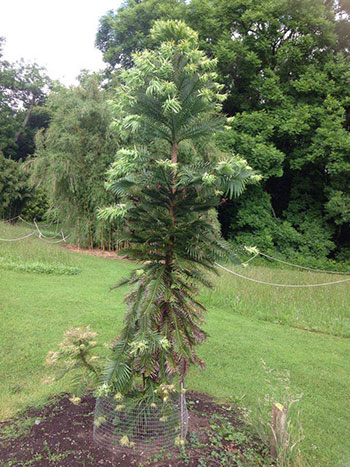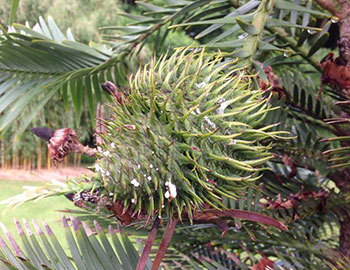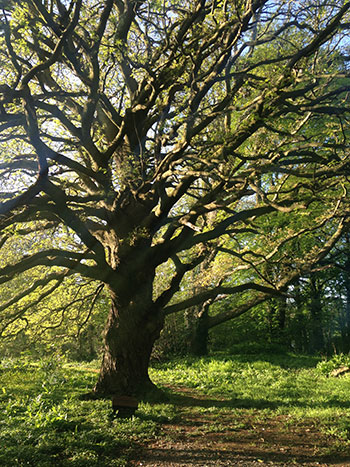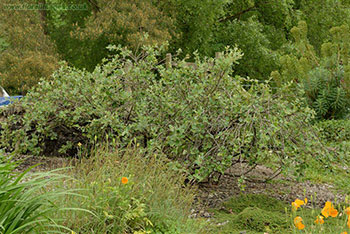Notable Plants
Wollemi Pine (Wollemia nobilis)
 Wollemia nobilis is of exceptional botanical interest as it was only discovered, new to science, in S.E.Australia in 1994. It represents a hitherto unknown genus with direct evolutionary links to the Monkey Puzzle (Araucaria auracana), Norfolk Island Pine (Araucaria heterophylla) as well as Kauri Pine (Agathis australis).
Wollemia nobilis is of exceptional botanical interest as it was only discovered, new to science, in S.E.Australia in 1994. It represents a hitherto unknown genus with direct evolutionary links to the Monkey Puzzle (Araucaria auracana), Norfolk Island Pine (Araucaria heterophylla) as well as Kauri Pine (Agathis australis).
Added to this is the remarkable similarity shared by Wollemia and some well-preserved fossil foliage of conifers which grew in several parts of the Southern Hemisphere 90 million years ago and previously believed to have gone extinct 2 million years ago, making Wollemia a so called ‘Living Fossil.’
The Wollemia at Treborth was planted in 2007 by naturalist and Honorary Fellow of Bangor University, Iolo Williams and is situated just beyond the rock garden in an open site.
10 Wollemi Facts:

- Wollemia nobilis is a conifer but not a Pine – it belongs to the family Araucariaceae, a group of southern hemisphere conifers which reached maximum diversity during the Jurassic and Cretaceous Periods, 200-65 million years ago.
- It is currently known from one remote region of the Wollemi National Park, a 500,000 hectare wilderness zone in New South Wales, Australia, part of the Greater Blue Mountains World Heritage Area. The locality, which remains secret, is a series of deep sandstone gorges clothed in temperate rainforest.
- There are fewer than 100 specimens in the wild and DNA sampling has so far failed to find any detectable genetic variation - effectively the surviving population is clonal.
- The tallest trees are up to 40 metres high (and at least 350 years old) with a one metre diameter trunk (though many individuals naturally coppice and produce a dozen or more slender trunks). The bark is bobbly and the evergreen leaves vary in length and width and shade of green according to the age of the shoots.
- Mature trees bear male and female cones on separate shoots, the female cone (seed cone) being green and 6-12cm long, 5-10cm wide, taking 18-20 months to mature. Male cones are slender, 5-11cm long and 1-2 cm broad.
- Modern micropropagation methods are used to provide sufficient new plant stock to both ensure Wollemia’s future survival as well as satisfy an enormous horticultural demand for what is undoubtedly a most distinctive and handsome coniferous tree with great ornamental potential.
- In cultivation the tree is proving adaptable and robust, surviving temperatures between minus 5 degrees centigrade and 45 degrees centigrade as well as a wide range of soil types, though a well-drained compost of pH 6 or less is preferable. It appears to be suitable for tub planting and takes sun or shade.
- The main pest is the root rot fungus Phytophthora cinnamomi.
- Treborth’s tree measured 1.2m at the time of planting (July 2007) – it now measures 2.25m (June 2016).
- In September 2012, the Wollemia set seed for possibly the first time in Wales and only the second time in the UK.
Mountain Cypress, Cape Cypress (Widdringtonia nodiflora)
A shrubby tree from exposed mountain slopes from S.W. Cape to Limpopo River, it is rare in the wild, and seldom seen in gardens. It was a gift from Glasnevin, and is a commemoration tree. Hardy only in the west of the UK, this species belongs to the Cupressaceae, has scale leaves typical of that family, a xerophytic feature, as appropriate to its seasonally dry native area. Its bushy form is typical of the species and it produces a profuse crop of female cones, which are attractive, hard and leathery: the male cones are far smaller. Unlike other members of its genus, this species is capable of coppicing and resprouts after fire. Come and see the Widdringtonia opposite the Southern African border down on the main lawn.
Lucombe Oaks (Quercus x hispanica 'Lucombeana')
 The Lucombe Oak is a cross between Turkey Oak (Quercus cerris) and Cork Oak (Quercus suber). William Lucombe (before 1720 – after 1785) was a nurseryman, who gave his name to the Lucombe Oak (Quercus x hispanica 'Lucombeana'). He bred it at his nursery in St Thomas, Exeter which he founded in 1720. The Lucombe Oak was first spotted in 1762 when Lucombe noticed that one of the saplings produced from a Turkey Oak acorn he had planted kept its leaves in winter. He later observed that these features occurred where both parents (Turkey Oak and Cork Oak) grew. True Lucombe Oaks are clones of the original tree, but Lucombe Oak is also often used to refer to any hybrid between Turkey Oak and Cork Oak.
The Lucombe Oak is a cross between Turkey Oak (Quercus cerris) and Cork Oak (Quercus suber). William Lucombe (before 1720 – after 1785) was a nurseryman, who gave his name to the Lucombe Oak (Quercus x hispanica 'Lucombeana'). He bred it at his nursery in St Thomas, Exeter which he founded in 1720. The Lucombe Oak was first spotted in 1762 when Lucombe noticed that one of the saplings produced from a Turkey Oak acorn he had planted kept its leaves in winter. He later observed that these features occurred where both parents (Turkey Oak and Cork Oak) grew. True Lucombe Oaks are clones of the original tree, but Lucombe Oak is also often used to refer to any hybrid between Turkey Oak and Cork Oak.
We have two specimens at Treborth, believed to have been planted by Sir Joseph Paxton, a leading Victorian landscape designer as part of his Britannia Park plans.
Strangler Fig (Ficus aurea)

Lurking at the back of the Tropical House grows a beautiful but sinister plant that constricts its victims, while growing up into the canopy to compete for their light. Ficus aurea, the strangler fig is a tree from the Moraceae family that starts its life as an epiphytic seedling. As it grows in a crevice of its host (usually another tropical tree species), it sends down aerial roots that eventually make contact and establish in the ground. With terrestrial roots, it can now enlarge and engulf its host, competing with it for nutrients, water and light. It effectively girdles its host and kills it. The resulting Ficus is a large hollow tree with a strong lattice trunk.
Another remarkable phenomenon associated with the genus Ficus, is their obligate mutualism (relationship) with fig wasps. Fig species are only pollinated by fig wasps and fig wasps can only pollinate fig species. The thick flesh inside a fig that we love to eat, is in fact the pollinated female flowers. So a fig is a fruit with flowers inside it! F. aurea have both male and female flowers within the syconium (the fruit). Female flowers mature first and produce a chemical attractant that attracts female wasps. These wasps squeeze their way through a small hole into the interior of the syconium, and once inside they pollinate the flowers, lay their eggs in some of them, and then die.
The eggs hatch and the larvae parasitise the flowers in which they were laid. After four to seven weeks (in F. aurea), the adult wasps emerge. These wasps mate, and cut exit holes through the walls of the fig. The male flowers mature around the same time as the female wasps emerge. The newly emerged female wasps actively pack their bodies with pollen from the male flowers before leaving through the exit holes the males have cut and fly off to find a syconium in which to lay their eggs. Over the next one to five days, figs ripen.
Our strangler fig was introduced to the Tropical House in 1979, and has colonised the furthest end, sending large finger-like aerial roots into the pond below. It is a magnificent specimen but requires regular severe pruning to stop it from smothering everything else!
Wild Cotoneaster (Cotoneaster cambricus)

Wild Cotoneaster (Cotoneaster cambricus) is also known as the Great Orme Berry or Creigafal y Gogarth (rock apple). It has attractive grey-green oval leaves that are woolly beneath and measure 15-40mm. Pink-white flowers around 3mm in diameter appear from April to June in clusters of 2-4. The berries are small (5-8mm across) and bright orange-red in colour, resembling a miniature apple. The Great Orme is the only known locality for this plant in the UK where it grows on isolated and exposed cliff ledges.
It was originally thought that this plant may be Cotoneaster integerrimus, which may have been introduced to the UK. However recent genetic evidence from Royal Botanic Gardens, Kew has shown it to be a native species in its own right, Cotoneaster cambricus. When the plant was first recorded in the eighteenth century, it was described as being widely distributed at the locality but by 1978 it had declined to six individuals. Today the population has since been supplemented by the introduction of new plants grown in cultivation.
As well as being listed as a species in the Conwy Local Biodiversity Action Plan Cotoneaster cambricus is also designated as a UK Biodiversity Action Plan species – highlighting the need for action to conserve this species.
Wild Cotoneaster plants have been sent to Kew, Ness and Treborth Botanic Garden to maintain specimens of the plant outside of the Great Orme. Our specimens are located on the top limestone end of the rock garden where is grows in free-draining, calcareous substrate.
Click here to find out more about Cotoneaster cambricus Species Action Plan.
Newsletters
Conservation propagation of Cotoneaster cambricus
Conservation propagation – a legacy project
